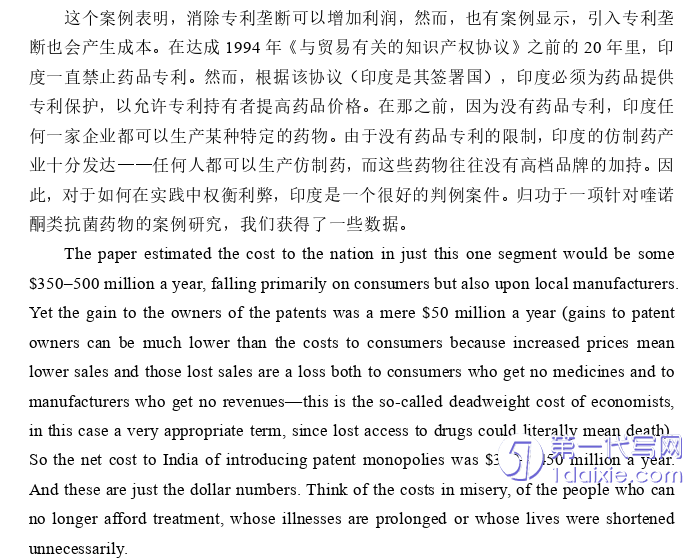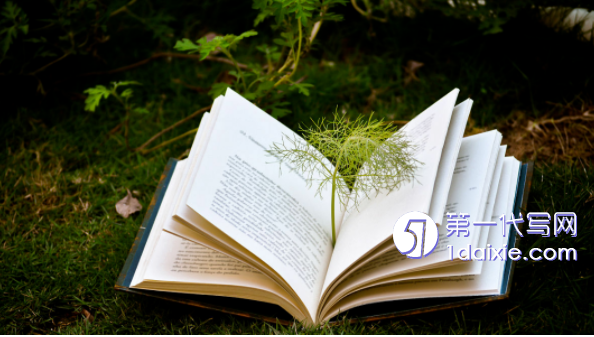本文是一篇英语论文,本次翻译实践表明,奈达的功能对等理论可以为信息型文本的翻译提供有效指导。在翻译过程中,译者必须兼顾词汇、句法和语篇等层面的翻译,确保译文准确传达原文信息。此外,望本报告能为同类型文本的翻译提供参考。
PartⅠIntroduction
1.1 Materials of Translation
The Open Revolution:Reproducing the Rules of the Information Age is written byRufus Pollock,a pioneer of the global open data movement.Rufus Pollock holds a Ph.D.in Economics and a double first in Mathematics from the University of Cambridge.He hasprovided useful suggestions for governments,international organizations and relevantindustries on how to succeed in the digital world.
The Open Revolution:Reproducing the Rules of the Information Age consists of 12chapters.It focuses on how to completely change the ownership of information in thedigital economy.Today’s“closed”digital economy is the root of all kinds of problems,from growing inequality to unaffordable drugs,to the power of a few technologymonopoly enterprises to control the way people think and vote.Rufus Pollock describes apath to a more equitable,innovative and profitable future for all.
The source text of this translation project is selected from Chapter 10 to Chapter 12 ofThe Open Revolution:Reproducing the Rules of the Information Age,which discusses theunfair information monopoly in all walks of life.The author of the original book proposesto replace the monopoly of intellectual property rights with the remuneration right to createan open world of information.
1.2 Objectives and Significance of Translation
The objectives of translating this source text are as follows.Firstly,readers will learnthat an open revolution will encourage more scientists to work in cutting-edge knowledgeareas and create an era of fairness and innovation.Secondly,readers will be aware thatthere are many challenges on data opening.With the improvement of today’s science andtechnology,the digital economy brings more possibilities to the world.How to start fromthe dimension of data and focus on social public interests is the direction that countriesaround the world are exploring.Thirdly,this translation project can meet the reading needsof domestic readers who are interested in this type of text.
The translation of this source text is of great significance.Firstly,this translationproject is expected to enrich relevant research.A search on China National KnowledgeInfrastructure found that 302 papers involved“information monopoly”.However,there islittle research on information monopoly in the digital economy era in China.Most of theresearch of domestic scholars focuses on big data,blockchain and marketing,but few onthe digital economy and information openness.Secondly,the comprehensive ability of thereport author has improved.By studying the characteristics of the text and collectingparallel texts,the report author has greatly improved the ability of data collection,translation synthesis and analysis.Thirdly,this translation project is a challenge for thereport author,who has accumulated practical experience and improved translation skills intranslating.
PartⅡTranslation Process
2.1 Pre-translation Preparation
The more carefully the preparation work is done,the better the translation efficiencywill be.Therefore,pre-translation work is divided into four steps to ensure properpreparation for this translation project.
Firstly,ensuring the originality and translatability of the translation.On the one hand,the report author had searched for the translated version of The Open Revolution:Reproducing the Rules of the Information Age through the National Library,CNKI,Wikipedia,and other channels.After verification,it was found that there was no officialChinese translation of the source text.On the other hand,in order to ensure thetranslatability of the text,the report author had carefully read the source text to grasp themain idea and its overall style.In addition,the report author also looked up the writingbackground of the novel,which gained a better understanding of the author’s writing styleand characteristics by researching the author’s biography and similar works.
Secondly,reading parallel texts.The parallel text is mainly used to better understandthe source text.When translating texts in unfamiliar fields,reading parallel texts can helpthe report author not only understand the content but also supplement her professionalknowledge and determine the translation methods of professional expressions.For example,some rare medical words and professional terms are involved in the source text.In order toensure the accuracy of the translation of professional terms,the report author translatedtheir correct meanings by searching relevant parallel texts.In addition,the report authoralso read some parallel texts similar to the material,such as The Wealth of Network,whichis more consistent with the translated materials in terms of the text style and its languageexpressions can be referenced.Reading parallel texts allowed the report author to learn andrefer to some similar useful expressions,and gained a more comprehensive understandingof the content and writing style of information texts,which greatly improved the efficiencyand accuracy of the translation.
2.2 While-translation Work
The work during this translation project primarily covers three steps.
Firstly,reading the source text several times,comprehending the meaning of thesource text,and striving to faithfully convey the text’s information.When encountering thenames and professional terms of some institutions and organizations,the report authorconsulted the relevant literature to accurately convey the original information to the targetreaders.
Secondly,considering the differences in expression habits between the target languagereaders and the source language readers.English focuses on hypotaxis and often uses longsentences.However,Chinese emphasizes parataxis and short sentences often appear.Therefore,when translating long sentences,the report author first analyzed thecomposition and structure of long and difficult sentences,then divided them into shortsentences.Besides,the report author flexibly used some translation methods such asdivision,amplification and restructuring to convey the information of the source text.
Thirdly,recording the key points and difficulties encountered in the translationprocess.These difficulties were marked in different colors for discussion with peers later.The report author summarized the difficulties and key points of the same type by takingnotes,which was beneficial for case analysis.
Part Ⅲ Theoretical Framework ............................. 7
3.1 Introduction of Functional Equivalence Theory ................................ 7
3.2 The Application of Functional Equivalence Theory .......................... 8
Part Ⅳ Case Study ...................................... 9
4.1 Translation at the Lexical Level ................................. 9
4.1.1 Translation of Part of Speech .............................. 9
4.1.2 Translation of Chinese Four-character Phrases .......................... 10
Part Ⅴ Conclusion ................................. 21
5.1 Gains ........................................ 21
5.2 Limitations ............................... 21
PartⅣCase Study
4.1 Translation at the Lexical Level
Vocabulary is the carrier of language and the basis for effectively conveying themeaning of the text.An accurate understanding of the meaning of keywords in eachsentence is the premise of understanding the full text(Sun,2010).In order to achieve theequivalence at the lexical level,appropriate words or phrases should be selected.

4.1.1 Translation of Part of Speech
The ultimate goal of translation is to achieve the equivalence in content and functionwith the source text,rather than pursuing formal correspondence(Xu,2007).Therefore,inthe practice of English-Chinese translation,the report author converts some parts of speechin English into another part of speech in Chinese to boost the translation accuracy.
Case 1
ST:Without the anticipation of high returns,companies and their investors mightnever risk the expense of research,and rather than high-priced drugs we’d simply have nodrugs at all.(p.25)
TT:如果预期回报低微,公司和投资者不会贸然投入大量资金进行研究。这样一来,我们将无药可用,遑论高价药物。(p.25)
Analysis:When translated into Chinese,nouns with verb meanings can be convertedinto verbs,so as to better conform to the expression habits of Chinese(Ye,2007).In Case 1,the word“expense”is a noun.As a noun,it means“费用”and“花费”.If it was translateddirectly according to its original part of speech,the smoothness of the translation wouldnot be guaranteed.Therefore,the verb form“expense”should be taken and translated as“投入大量资金”to avoid obscure.Not only does the translation convey the accurateinformation of the source text,but also it conforms to the principle of the functionalequivalence theory,that is,meaning comes first and is followed by form.

PartⅤConclusion
5.1 Gains
In this translation project,valuable experience is summed up as follows.
Firstly,pre-translation preparations are essential for a fine translation.Collecting theinformation might be helpful in translating,including the background of the source textand the author’s information.Furthermore,understanding the source text might help tobetter convey the connotation information of the source text during translation andachieve functional equivalence between content and form as much as possible.Besides,using the parallel texts will help the report author to be familiar with the expressionhabits of relevant texts.
Secondly,the report author has gained further understanding of the functionalequivalence theory.Before translation,the report author has read a lot of literature aboutfunctional equivalence theory and become more familiar with it.This plays an importantrole in guiding the translation of the source text.In addition,the report author learns howto flexibly combine functional equivalence theory with practice through this translationpractice.
Thirdly,the report author has learned the relevant knowledge on informationmonopoly and remuneration right,which has expanded the report author’s knowledgeand basic mastery of the features of informative texts.However,due to the significantdifferences between Chinese and English in sentence structure,the report author oftenencounters situations where it is difficult to balance formal equivalence and contentequivalence.Therefore,when translating informational texts,some principles should befollowed:be faithful to the source text and convey accurate information;be fluent andconform to the readers’reading habits;be readable so that the readers can understand.
reference(omitted)
